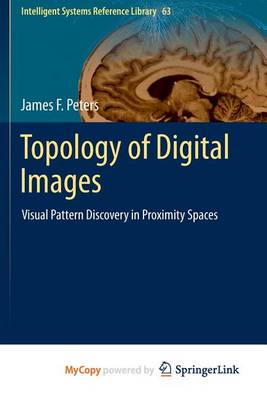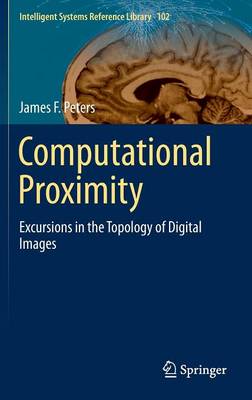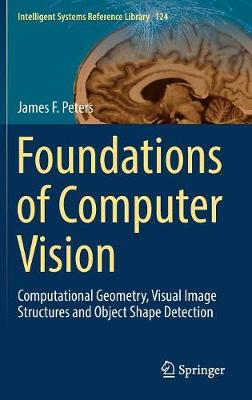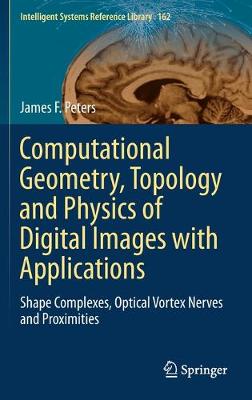Intelligent Systems Reference Library
4 primary works
Book 63
This book carries forward recent work on visual patterns and structures in digital images and introduces a near set-based a topology of digital images. Visual patterns arise naturally in digital images viewed as sets of non-abstract points endowed with some form of proximity (nearness) relation. Proximity relations make it possible to construct uniform topologies on the sets of points that constitute a digital image. In keeping with an interest in gaining an understanding of digital images themselves as a rich source of patterns, this book introduces the basics of digital images from a computer vision perspective. In parallel with a computer vision perspective on digital images, this book also introduces the basics of proximity spaces. Not only the traditional view of spatial proximity relations but also the more recent descriptive proximity relations are considered. The beauty of the descriptive proximity approach is that it is possible to discover visual set patterns among sets that are non-overlapping and non-adjacent spatially. By combining the spatial proximity and descriptive proximity approaches, the search for salient visual patterns in digital images is enriched, deepened and broadened. A generous provision of Matlab and Mathematica scripts are used in this book to lay bare the fabric and essential features of digital images for those who are interested in finding visual patterns in images. The combination of computer vision techniques and topological methods lead to a deep understanding of images.
Book 102
This book introduces computational proximity (CP) as an algorithmic approach to finding nonempty sets of points that are either close to each other or far apart. Typically in computational proximity, the book starts with some form of proximity space (topological space equipped with a proximity relation) that has an inherent geometry. In CP, two types of near sets are considered, namely, spatially near sets and descriptivelynear sets. It is shown that connectedness, boundedness, mesh nerves, convexity, shapes and shape theory are principal topics in the study of nearness and separation of physical aswell as abstract sets. CP has a hefty visual content. Applications of CP in computer vision, multimedia, brain activity, biology, social networks, and cosmology are included. The book has been derived from the lectures of the author in a graduate course on the topology of digital images taught over the past several years. Many of the students have provided important insights and valuable suggestions. The topics in this monograph introduce many forms of proximities with a computational flavour (especially, what has become known as the strong contact relation), many nuances of topological spaces, and point-free geometry.
Book 124
This book introduces the fundamentals of computer vision (CV), with a focus on extracting useful information from digital images and videos. Including a wealth of methods used in detecting and classifying image objects and their shapes, it is the first book to apply a trio of tools (computational geometry, topology and algorithms) in solving CV problems, shape tracking in image object recognition and detecting the repetition of shapes in single images and video frames. Computational geometry provides a visualization of topological structures such as neighborhoods of points embedded in images, while image topology supplies us with structures useful in the analysis and classification of image regions. Algorithms provide a practical, step-by-step means of viewing image structures.
The implementations of CV methods in Matlab and Mathematica, classification of chapter problems with the symbols (easily solved) and (challenging) and its extensive glossary of key words, examples and connections with the fabric of CV make the book an invaluable resource for advanced undergraduate and first year graduate students in Engineering, Computer Science or Applied Mathematics.
It offers insights into the design of CV experiments, inclusion of image processing methods in CV projects, as well as the reconstruction and interpretation of recorded natural scenes.
Book 162
Computational Geometry, Topology and Physics of Digital Images with Applications
by James F. Peters
This book discusses the computational geometry, topology and physics of digital images and video frame sequences. This trio of computational approaches encompasses the study of shape complexes, optical vortex nerves and proximities embedded in triangulated video frames and single images, while computational geometry focuses on the geometric structures that infuse triangulated visual scenes.
The book first addresses the topology of cellular complexes to provide a basis for an introductory study of the computational topology of visual scenes, exploring the fabric, shapes and structures typically found in visual scenes. The book then examines the inherent geometry and topology of visual scenes, and the fine structure of light and light caustics of visual scenes, which bring into play catastrophe theory and the appearance of light caustic folds and cusps. Following on from this, the book introduces optical vortex nerves in triangulated digital images. In this context, computational physics is synonymous with the study of the fine structure of light choreographed in video frames. This choreography appears as a sequence of snapshots of light reflected and refracted from surface shapes, providing a solid foundation for detecting, analyzing and classifying visual scene shapes.



